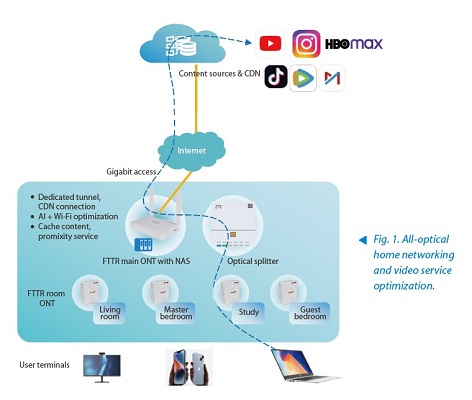Device-Network Collaboration for High-Quality Home Video Experience
Home video services have become an integral part of daily life, encompassing low-latency live streaming, entertaining short videos, and immersive VR experiences. As home users increasingly demand higher video quality, home networks must collaboratively optimize video services to provide users with a superior viewing experience (Fig. 1). This article explores how to achieve a high-quality home video experience through device-network collaboration across three aspects within the home: the access layer, transmission layer, and content layer.

Access Layer: DNS and Tunneling Technologies for Interfacing with Upstream CDNs to Enhance Performance
The access layer serves as the connection point between home networks and external networks, and its performance directly affects the quality of video service transmission. To achieve high-quality video transmission, home networks can employ the domain name system (DNS) and tunneling technologies to interface with upstream content delivery networks (CDNs).
DNS, as the core of the domain name system, is responsible for resolving user requests for domain names into their corresponding IP addresses. In the home network, optimizing the DNS resolution process is crucial for enhancing the response speed of video services. By utilizing built-in DNS services and caching techniques, the home network can reduce query time, accelerating video content loading.
Additionally, the use of VPN, MPLS, and other tunneling technologies can establish secure and reliable connections between the home networks and upstream CDNs. These technologies ensure the security and stability of video data during transmission, preventing data loss or tampering. They also enable low-latency connections, ensuring real-time and fast transmission of video data to user devices.
Transmission Layer: Building Optimal Video Channels with Wi-Fi and SCP
The transmission layer is a crucial component of home networks, and its performance directly affects the quality of video transmission. The smart cloud platform (SCP) is the first integrated home network management platform in the industry that optimizes Wi-Fi performance, identifies services, optimizes the network, and ensures video quality of service (QoS) to create the best home video transmission channel.
Wi-Fi quality is the foundation of wireless network transmission, with its stability directly affecting video quality. As the number of wireless devices increases, channel congestion becomes a significant issue. The SCP platform can intelligently select and manage Wi-Fi channels. Utilizing the AI technology, it monitors the load of each channel in real-time, predicts future traffic changes, and automatically selects the optimal channel for video transmission, ensuring stable data transmission.
Service identification is key to network optimization. In complex network environments, different services have varying requirements and priorities for network resources. The SCP platform can accurately identify critical services such as video streams, online meetings, and live broadcasts through big data analysis, optimizing the network based on their characteristics and needs. This includes adjusting resource allocation and configuring QoS to ensure smooth and clear video transmission.
Network optimization is essential for enhancing video service quality. The SCP can predict the possibility and location of network congestion by analyzing historical data and real-time traffic, identify potential issues, and issue warnings to ensure network stability and reliability. Additionally, the SCP intelligently determines solutions for existing problems and performs automatic repairs to enhance the video experience.
Content Layer: Expanding Storage Capacity, Preheating Content and Offering Proximity Services with FTTR
The content layer is crucial for the storage and distribution of video content within home networks, and its performance directly affects the loading speed of video services. To achieve high-quality video loading speed, home networks can adopt strategies such as fiber to the room (FTTR) to expand storage capacity, preheat content, and offer proximity services at the content layer.
First, FTTR technology provides users with higher bandwidth access capabilities. By expanding storage capacity with FTTR, home networks can cache more video content, reducing reliance on upstream CDNs and minimizing transmission delays. Additionally, FTTR also enables high-speed transmission within the home network, ensuring that video data can be quickly transferred from storage devices to user devices.
Second, content preheating is a strategy for pre-loading and caching video content before viewing. By preheating content, users can start watching videos faster and reduce waiting time. The home network can intelligently predict and preheat related video content based on user viewing history and preferences. This improves user experience and reduces bandwidth pressure on upstream CDNs.
Lastly, proximity service refers to storing video content closer to users, such as on home NAS devices or routers, to enable fast loading and viewing. It reduces the transmission distance and time of video data, lowers transmission delays, and improves the viewing experience. Home networks can use FTTR technology to store video content on home devices and transfer it quickly to user devices through high-speed transmission.
In the future, continuous technological advancements will make device-network collaboration the core of home video experiences. By integrating terminal devices with network optimization, users will enjoy an unprecedented high-quality video experience. Home video will no longer be limited by network bandwidth or device performance, enabling seamless, high-definition, and smooth transmission and playback. With SCP empowering home networks, service identification will become more accurate, and network optimization more intelligent, further enhancing the quality and efficiency of video services. Device-network collaboration will enrich the home video experience, meeting users’ growing needs and ushering in a new era of home entertainment.